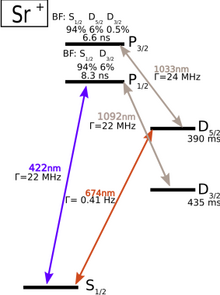Branching fraction
In particle physics and nuclear physics, the branching fraction (or branching ratio) for a decay is the fraction of particles that decay by an individual decay mode or with respect to the total number of particles which decay. It applies to either the radioactive decay of atoms or the decay of elementary particles.[1] It is equal to the ratio of the partial decay constant to the overall decay constant. Sometimes a partial half-life is given, but this term is misleading; due to competing modes, it is not true that half of the particles will decay through a particular decay mode after its partial half-life. The partial half-life is merely an alternate way to specify the partial decay constant λ, the two being related through:
For example, for decays of 132Cs, 98.1% are ε (electron capture) or β+ (positron) decays, and 1.9% are β− (electron) decays. The partial decay constants can be calculated from the branching fraction and the half-life of 132Cs (6.479 d), they are: 0.10 d−1 (ε + β+) and 0.0020 d−1 (β−). The partial half-lives are 6.60 d (ε + β+) and 341 d (β−). Here the problem with the term partial half-life is evident: after (341+6.60) days almost all the nuclei will have decayed, not only half as one may initially think.
Isotopes with significant branching of decay modes include copper-64, arsenic-74, rhodium-102, indium-112, iodine-126 and holmium-164.
Branching fractions of atomic states

In the field of atomic, molecular, and optical physics, a branching fraction refers to the probability of decay to a specific lower-lying energy states from some excited state. Suppose we drive a transition in an atomic system to an excited state |e⟩, which can decay into either the ground state |g⟩ or a long-lived state |d⟩. If the probability to decay (the branching fraction) into the |g⟩ state is , then the probability to decay into the other state |d⟩ would be .[2] Further possible decays would split appropriately, with their probabilities summing to 1.
In some instances, instead of a branching fraction, a branching ratio is used. In this case, the branching ratio is just the ratio of the branching fractions between two states. To use our example from before, if the branching fraction to state |g⟩ is , then the branching ratio comparing the transition rates to |g⟩ and |d⟩ would be .
Measurement
Branching fractions can be measured in a variety of ways, including time-resolved recording of the atom's fluorescence during a series of population transfers in the relevant states.[3][2]
A sample measuring procedure for a three state Λ-system that includes ground state |g⟩, excited state |e⟩, and long-lived state |d⟩, is as follows:
First, prepare all atoms in the ground state. Pump laser, which drives transition between ground state and the excited state is then turned on, and a photomultiplier (PMT) is used to count the "blue photon" emitted during the transition. Record the counted blue photon as N.
Every time an atom is driven to the excited state, it has probability of decaying to long-lived state. Therefore, while the pump laser is on, more and more atom would end up in the long-lived state, where they cannot be addressed by the cooling laser.
After all the atoms are in the |d⟩ state, apply repump laser, which drives the transition between |d⟩ and |e⟩. During this process each atom emits one blue photon. Denote number of emitted blue photon during this process as n.
Then the branching fraction for |e⟩ decaying to |g⟩ is
References
- ^ IUPAC, Compendium of Chemical Terminology, 2nd ed. (the "Gold Book") (1997). Online corrected version: (2006–) "branching fraction". doi:10.1351/goldbook.B00725
- ^ a b Ramm, Michael; Pruttivarasin, Thaned; Kokish, Mark; Talukdar, Ishan; Häffner, Hartmut (2013-07-12). "Precision measurement method for branching fractions of excited P(1/2) states applied to 40Ca+". Physical Review Letters. 111 (2): 023004. arXiv:1305.0858. doi:10.1103/PhysRevLett.111.023004. ISSN 1079-7114. PMID 23889393.
- ^ Zhang, Helena; Gutierrez, Michael; Low, Guang Hao; Rines, Richard; Stuart, Jules; Wu, Tailin; Chuang, Isaac (2016-12-15). "Iterative precision measurement of branching ratios applied to 5 P states in 88 Sr +". New Journal of Physics. 18 (12): 123021. arXiv:1605.04210. doi:10.1088/1367-2630/aa511d. ISSN 1367-2630.
External links
- LBNL Isotopes Project
- Particle Data Group (listings for particle physics)
 Nuclear Structure and Decay Data - IAEA for nuclear decays
Nuclear Structure and Decay Data - IAEA for nuclear decays





